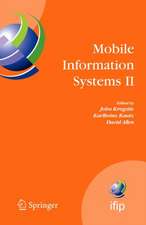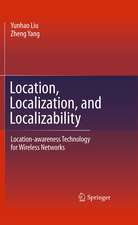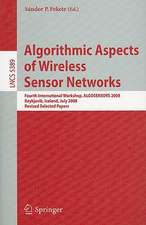Content Distribution for Mobile Internet: A Cloud-based Approach
Autor Zhenhua Li, Yafei Dai, Guihai Chen, Yunhao Liuen Limba Engleză Hardback – 15 feb 2023
Motivated by the trend of “heavy-cloud vs. light-end,” this book is dedicated to uncovering the root causes of today’s mobile networking problems and designing innovative cloud-based solutions to practically address such problems. Our work has produced not only academic papers published in prestigious conference proceedings like SIGCOMM, NSDI, MobiCom and MobiSys, but also concrete effects on industrial systems such as Xiaomi Mobile, MIUI OS, Tencent App Store, Baidu PhoneGuard, and WiFi.com. A series of practical takeaways and easy-to-follow testimonials are provided to researchers and practitioners working in mobile networking and cloud computing. In addition, we have released as much code and data used in our research as possible to benefit the community.
| Toate formatele și edițiile | Preț | Express |
|---|---|---|
| Paperback (2) | 757.01 lei 43-57 zile | |
| Springer Nature Singapore – 6 iun 2018 | 757.01 lei 43-57 zile | |
| Springer Nature Singapore – 16 feb 2024 | 1156.45 lei 43-57 zile | |
| Hardback (1) | 1162.70 lei 43-57 zile | |
| Springer Nature Singapore – 15 feb 2023 | 1162.70 lei 43-57 zile |
Preț: 1162.70 lei
Preț vechi: 1453.37 lei
-20% Nou
Puncte Express: 1744
Preț estimativ în valută:
222.50€ • 230.89$ • 185.98£
222.50€ • 230.89$ • 185.98£
Carte tipărită la comandă
Livrare economică 17-31 martie
Preluare comenzi: 021 569.72.76
Specificații
ISBN-13: 9789811969812
ISBN-10: 9811969817
Pagini: 252
Ilustrații: XVI, 252 p. 71 illus. in color.
Dimensiuni: 155 x 235 mm
Greutate: 0.55 kg
Ediția:2nd ed. 2023
Editura: Springer Nature Singapore
Colecția Springer
Locul publicării:Singapore, Singapore
ISBN-10: 9811969817
Pagini: 252
Ilustrații: XVI, 252 p. 71 illus. in color.
Dimensiuni: 155 x 235 mm
Greutate: 0.55 kg
Ediția:2nd ed. 2023
Editura: Springer Nature Singapore
Colecția Springer
Locul publicării:Singapore, Singapore
Cuprins
Part I Get Started.- 1 Background and Overview.- Part II Bandwidth Is The First Concern.- 2 Fast and Light Bandwidth Testing for Mobile Internet.- 3 Offline Downloading via Cloud and/or Smart APs.- Part III Never Waste on Traffic Usage.- 4 Cross-App Cellular Traffic Optimization.- 5 Boosting Mobile Virtual Network Operator.- Part IV Stay Connected At All Times.- 6 Enhancing Nationwide Cellular Reliability.- 7 Heading Off Fake Base Stations at Scale.- Part V Do Not Relax Our Vigilance.- 8 Combating Nationwide WiFi Security Threats.- 9 Understanding IoT Security with HoneyCloud.- Part VI Last Thoughts.- 10 Concluding Remarks.
Notă biografică
Zhenhua Li is an Associate Professor at the School of Software, Tsinghua University. He obtained his Ph.D. degree in Computer Science from Peking University in 2013. His research interests are chiefly in mobile networking, cloud computing, and big data analysis. His work focuses on understanding realistic problems in today’s large-scale mobile (cellular, WiFi, and IoT) systems, and on developing innovative solutions to practically address them. His research has produced not only academic papers published in prestigious conference proceedings like SIGCOMM, NSDI, MobiCom and MobiSys, but also concrete effects on industrial systems such as Xiaomi Mobile, MIUI OS, Tencent App Store, Baidu PhoneGuard, and WiFi.com, benefiting hundreds of millions of mobile users.
Yafei Dai is a Full Professor at the School of Electronics Engineering and Computer Science (EECS), Peking University. Before joining Peking University, she held positions as a Full Professor, Associate Professor, and Assistant Professor at the Department of Computer Science and Technology, Harbin Institution of Technology (HIT) in China starting in 1987. She obtained the Ph.D. degree, M.S. degree, and B.E. degree from HIT in 1993, 1986, and 1982, respectively. Her research interests are mainly in distributed systems, storage systems, and social networks. She has published over 100 academic papers in competitive conference proceedings and journals.
Guihai Chen is a Distinguished Professor at the Department of Computer Science and Engineering, Shanghai Jiao Tong University. He earned his Ph.D. degree in Computer Science from the University of Hong Kong in 1997, and has served as a Visiting Professor at Kyushu Institute of Technology in Japan, the University of Queensland in Australia, and Wayne State University in the USA. He has a wide range of research interests in parallel computing, wireless networks, peer-to-peer computing, high-performance computer architecture, and so on. He has published more than 200 papers in competitive conference proceedings and journals. He has won many honors and awards, in particular the First Prize of Natural Sciences by the Ministry of Education of China.
Yunhao Liu is a Changjiang Professor and Dean of Global Innovation Exchange at Tsinghua University. He received his Ph.D. degree and M.S. degree in Computer Science from Michigan State University in 2003 and 2004, respectively, and his B.S. degree from the Automation Department of Tsinghua University in 1995. His research interests include distributed systems, wireless sensor networks/RFID, Internet of Things (IoT), etc. He has published over 300 papers in prestigious conference proceedings and journals, as well as two books: “Introduction to IoT” and “Location, Localization, and Localizability.” He is currently the Editor-in-Chief of ACM Transactions on Sensor Networks and Communications of China Computer Federation. He is a Fellow of the ACM and IEEE.
Yafei Dai is a Full Professor at the School of Electronics Engineering and Computer Science (EECS), Peking University. Before joining Peking University, she held positions as a Full Professor, Associate Professor, and Assistant Professor at the Department of Computer Science and Technology, Harbin Institution of Technology (HIT) in China starting in 1987. She obtained the Ph.D. degree, M.S. degree, and B.E. degree from HIT in 1993, 1986, and 1982, respectively. Her research interests are mainly in distributed systems, storage systems, and social networks. She has published over 100 academic papers in competitive conference proceedings and journals.
Guihai Chen is a Distinguished Professor at the Department of Computer Science and Engineering, Shanghai Jiao Tong University. He earned his Ph.D. degree in Computer Science from the University of Hong Kong in 1997, and has served as a Visiting Professor at Kyushu Institute of Technology in Japan, the University of Queensland in Australia, and Wayne State University in the USA. He has a wide range of research interests in parallel computing, wireless networks, peer-to-peer computing, high-performance computer architecture, and so on. He has published more than 200 papers in competitive conference proceedings and journals. He has won many honors and awards, in particular the First Prize of Natural Sciences by the Ministry of Education of China.
Yunhao Liu is a Changjiang Professor and Dean of Global Innovation Exchange at Tsinghua University. He received his Ph.D. degree and M.S. degree in Computer Science from Michigan State University in 2003 and 2004, respectively, and his B.S. degree from the Automation Department of Tsinghua University in 1995. His research interests include distributed systems, wireless sensor networks/RFID, Internet of Things (IoT), etc. He has published over 300 papers in prestigious conference proceedings and journals, as well as two books: “Introduction to IoT” and “Location, Localization, and Localizability.” He is currently the Editor-in-Chief of ACM Transactions on Sensor Networks and Communications of China Computer Federation. He is a Fellow of the ACM and IEEE.
Textul de pe ultima copertă
Content distribution, i.e., distributing digital content from one node to another node or multiple nodes, is the most fundamental function of the Internet. Since Amazon’s launch of EC2 in 2006 and Apple’s release of the iPhone in 2007, Internet content distribution has shown a strong trend toward polarization. On the one hand, considerable investments have been made in creating heavyweight, integrated data centers (“heavy-cloud”) all over the world, in order to achieve economies of scale and high flexibility/efficiency of content distribution. On the other hand, end-user devices (“light-end”) have become increasingly lightweight, mobile and heterogeneous, creating new demands concerning traffic usage, energy consumption, bandwidth, latency, reliability, and/or the security of content distribution. Based on comprehensive real-world measurements at scale, we observe that existing content distribution techniques often perform poorly under the abovementioned new circumstances.
Motivated by the trend of “heavy-cloud vs. light-end,” this book is dedicated to uncovering the root causes of today’s mobile networking problems and designing innovative cloud-based solutions to practically address such problems. Our work has produced not only academic papers published in prestigious conference proceedings like SIGCOMM, NSDI, MobiCom and MobiSys, but also concrete effects on industrial systems such as Xiaomi Mobile, MIUI OS, Tencent App Store, Baidu PhoneGuard, and WiFi.com. A series of practical takeaways and easy-to-follow testimonials are provided to researchers and practitioners working in mobile networking and cloud computing. In addition, we have released as much code and data used in our research as possible to benefit the community.
Motivated by the trend of “heavy-cloud vs. light-end,” this book is dedicated to uncovering the root causes of today’s mobile networking problems and designing innovative cloud-based solutions to practically address such problems. Our work has produced not only academic papers published in prestigious conference proceedings like SIGCOMM, NSDI, MobiCom and MobiSys, but also concrete effects on industrial systems such as Xiaomi Mobile, MIUI OS, Tencent App Store, Baidu PhoneGuard, and WiFi.com. A series of practical takeaways and easy-to-follow testimonials are provided to researchers and practitioners working in mobile networking and cloud computing. In addition, we have released as much code and data used in our research as possible to benefit the community.
Caracteristici
Shows how to conduct realistic network and system measurements at scale in the field Provides comprehensive information on state-of-the-art mobile networking techniques Describes innovative content distribution solutions that suits various mobile application scenarios
Recenzii
“This is an interesting work offering solutions to upcoming traffic problems in mobile networks. Ample references are given.” (J. S. Edwards, Computing Reviews, March, 2017)



























